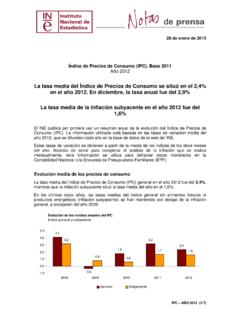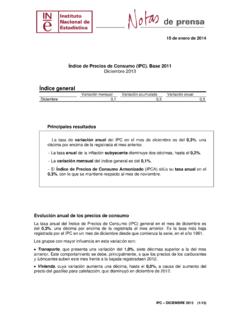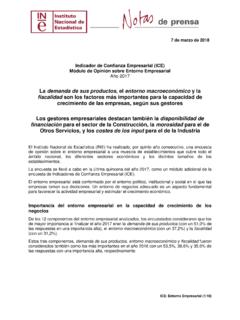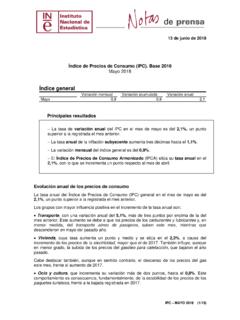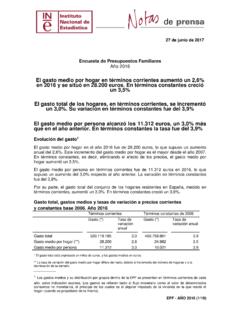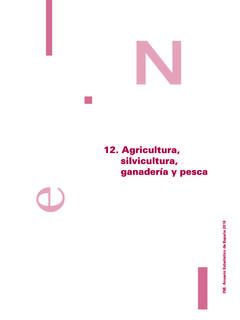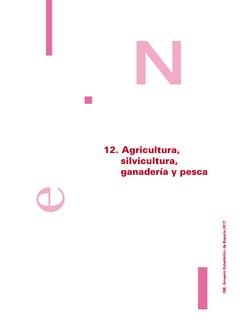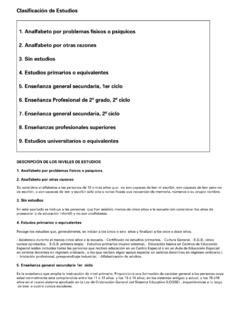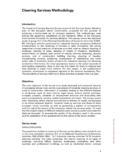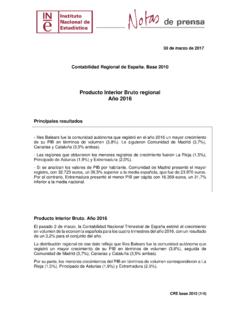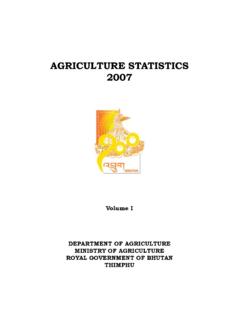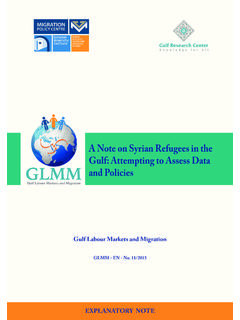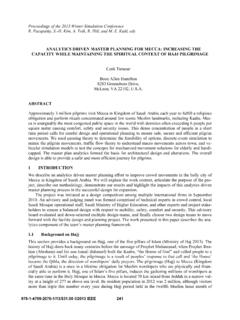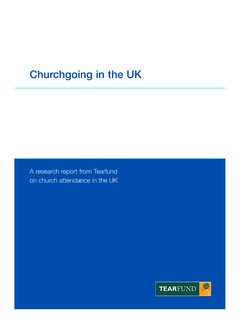Transcription of Statistics on Acquisition of Spanish Citizenship of ...
1 Statistics on Acquisition of Spanish Citizenship of Residents Methodology November 2020 Index 1 Introduction 3 2 Acquisition of Spanish Citizenship 3 3 Objectives 5 4 Definitions and concepts 5 5 Scope 7 6 Information processing 7 7 Calendar and dissemination plan 10 INE. National Statistics Institute3 1 Introduction Throughout the first years of the 21st century, our country has experienced one of the periods with the greatest demographic impetus of its history, fundamentally due to the massive arrival of inhabitants from beyond its borders. Cross-border mobility of populations is an increasingly visible social phenomenon that has transformed the social-demographic dynamic of Spain and which has represented an enormous challenge for the official Statistics . The Acquisition and measuring of Statistics for foreign population and their characteristics is extremely complex, in fact, it is one of the fields of official Statistics on an international level where this is still much to be improved in terms of consistency and comparability of information.
2 These needs are contained in the Regulation 862/2007 of the European Parliament and Council for Statistics for Migration and International Protection. Among other elements, this regulation demands annual information from member states for the people whose permanent residence is in the territory of the member state and who have acquired the nationality of the member state over the course of the reporting year. The main aim of the Statistics on Resident Acquisition of Spanish Citizenship is to provide a quantitative measure of these acquisitions. In addition, however, it represents one of the basic sources of information from which the Population figures are created since the last census in 2011. In this way, complete consistency is guaranteed between the sources of demographic information of the INE, and it enables the analysis of demographic change from the perspective of any of its components: births, deaths, migrations and acquiring nationality.
3 The creation of the Statistics on Resident Acquisition of Spanish Citizenship is based on the statistical treatment of the entries in nationality records in the Civil Registry. 2 Acquisition of Spanish Citizenship Articles 17 to 28 of the Civil Code (CC) consider the following ways in which Spanish nationality can be obtained: Spanish NATIONALITY: can be obtained as a result of ORIGIN - Those children born to a Spanish father or mother. - Those children born in Spain: a. To foreign parents if, at least, one of them was also born in Spain. b. To foreign parents, if both parents lacked a nationality, or if the legislation of neither of them attributes a nationality to the child (SIMPLE PRESUMPTION) c. Children born in Spain to parents of an unknown identity. - Children under the age of 18 adopted by a Spaniard (ADOPTION) INE.
4 National Statistics Institute4 Acquisition - BY CHOICE a. Those that are or have been under the parental authority of a Spaniard. b. Child of a Spanish father or mother born in Spain. c. Those persons whose parentage is determined after turning 18 or their birth in Spain. d. Those persons whose adoption on behalf of Spanish parents is accomplished after they have turned 18. - BY NATURALISATION CERTIFICATE Authorised by the crown and Spanish government. - RESIDENCE In Spanish territory CONSOLIDATION The possession and continued use of Spanish nationality for ten years (POSSESSING A STATUS) Furthermore, it can be lost (LOSSES) and recovered (RECOVERIES) Depending on this classification, the Statistics on Acquisition of Spanish Citizenship only take into consideration the processes that involve a change of nationality and that refer to people whose usual residence is in Spain.
5 It therefore excludes the nationalisations acquired by adoption and simple presumption, because they do not involve a change of nationality. It also excludes the nationalisations acquired by "Possessing a Status", because they do not involve a change of nationality, as it strictly applies to those persons that already act as Spanish (Article 18 CC). Losses and recoveries are not considered, because their reduced volume and the effect of compensation of the recoveries for losses mean that their exclusion is not significant. Since 2013, each month the INE receives the national record of new acquisitions or losses of Spanish Citizenship from the General Director of Registry Offices and the Notaries of the Ministry of Justice, which are recorded in the Civil Registry Offices, a process that culminates these administrative procedures and that establishes their effective date.
6 This information for nationalisations is used as input for the Statistics of the Population figures and, also from this year onwards, are forwarded to the European Office for Statistics , Eurostat. From 2015 onwards, they will be published each year in its own right by means of the Statistics for Residents Acquiring Spanish Citizenship , the series being started in the reporting year 2013. As of 2019, in June, a first publication of provisional data from the previous year is made, which is updated with the final data at the end of the year. Until 2013, the only available source on nationalisations were the Statistics on the Granting of Spanish Citizenship for Residence, prepared by the Ministry of Employment and Social Security, who continues to provide this information. This statistic differs from the Statistics on Acquisition of Spanish Citizenship in two key points: in only considers acquisitions by residents, and the reference date is the date the Citizenship was granted, which is a separate procedure that takes place prior to the actual Acquisition , leading to a time gap between both Statistics .
7 INE. National Statistics Institute5 3 Objectives The Statistics on Resident Acquisition of Spanish Citizenship are created for the achievement of three objectives: - The fundamental objective is to provide the number of persons whose permanent residence is in Spain and those persons that acquire Spanish nationality throughout the course of the reporting year, having previously had the nationality of another country or statelessness. - On the other hand, from the 2011 census onwards, and in coherence with it, the INE has created the statistical operation Population figures , which provides the information for the resident population and includes, among its disaggregation variables, the country of nationality and the country of birth of the inhabitant. An essential part of this operation consists of guaranteeing the complete consistency of the information in relation with demographic flows (births and deaths of the Natural Movement of the Population and migratory movements of the Statistics for Migrations) with the population stocks provided in all of the territorial and demographic levels considered.
8 The Statistics on Resident Acquisition of Spanish Citizenship is therefore complementary to the collection of demographic information and to close the circle of consistency between population figures and demographic events, by providing a quantitative measurement of the flow of nationalisations for each year and by enabling the correct classification of the information in terms of the country of nationality. - Finally, with these Statistics , they comply with the requirements for information considered by the Regulation 862/2007 of the European Parliament and Council for Statistics for Migration and International Protection in terms of the Acquisition of nationality. 4 Definitions and concepts The Statistics on Resident Acquisition of Spanish Citizenship quantify the volume of acquisitions of nationality that have occurred in a year, in line with a series of concepts and definitions that follow the international guidelines for such matter and, in particular, include what is established in the Regulation 862/2007 of the European Parliament and Council for Statistics for Migration and International Protection and in the Regulation 1260/2013 of the European Parliament and Council for European demographic Statistics .
9 These concepts are: Acquiring a nationality: Action by means of which a person acquires the nationality of the country of reference, having previously had either the nationality of another country or statelessness (without recognition of nationality on behalf of another state). Spanish legislation regulates various channels by means of which Spanish nationality can be obtained. Nevertheless, in accordance with what is established in the European regulation 862/2007, the Statistics on Resident Acquisition of Spanish Citizenship only take into consideration the processes that involve a change of nationality and that refer to people whose usual residence is in Spain and those are as follows: INE. National Statistics Institute6 - Acquisitions by residence: requires residence in Spain normally for ten years in a legal and continual manner prior to the application, although the time required is less in some cases.
10 - Acquisitions by naturalisation certificate: authorised by the crown and Spanish government. It has an ex gratia nature and it is not subject to the general regulations of the administrative procedure. - Acquisitions by choice: persons whose father or mother would have been Spanish and would have been born in Spain or that are or have been subject to the parental authority of a Spaniard, as well as in some other cases governed by Law, in short, the Law of Historical Memory that enables the Acquisition by choice for persons whose father or mother would originally have been Spanish and for the grandchildren of whomever lost of had to give up Spanish nationality as a result of exile. Resident population: is defined as the resident population in a given geographical area for those persons that on the reference date have their regular residence established therein.
